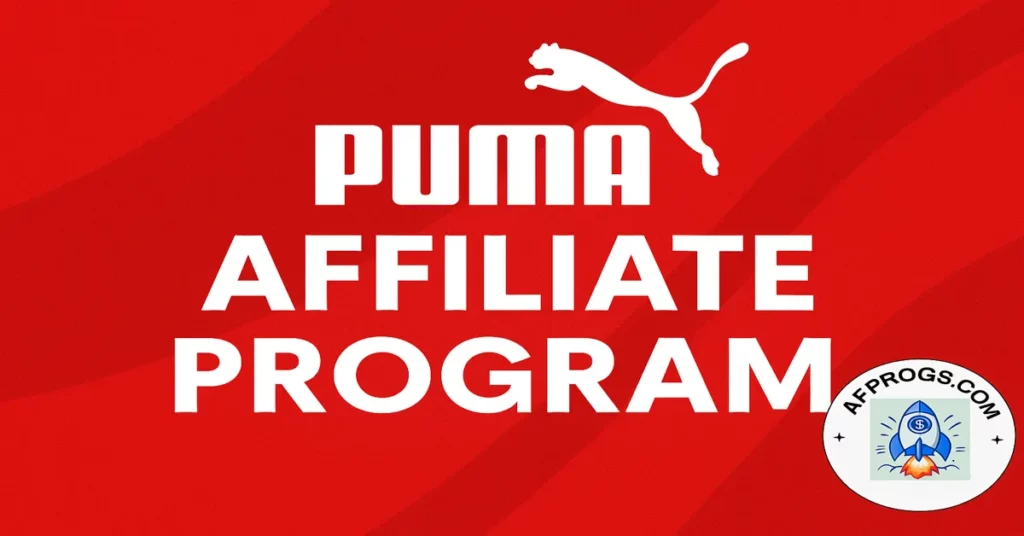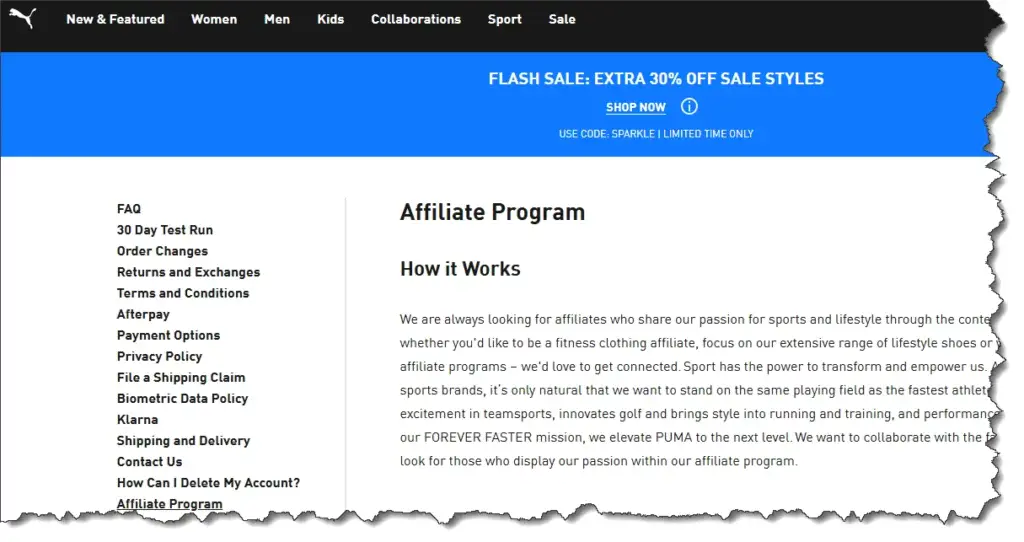
Wondering if the Puma affiliate program is worth joining this year?
The brand pulled in €8.8 billion last year and boasts 77% customer loyalty in the US—people clearly know (and return to) Puma.
Funnily enough, I once owned a Puma King sweater and a pair of Discs as a teenager—and I still wear their sports stuff today.
The opportunity runs through CJ Affiliate—the same network I used to push Star Wars costumes every Halloween.
CJ handles the tracking and payments while you promote running shoes, athleisure drops, and those Puma Hello Kitty collabs that sell surprisingly well.
Commission rates range from 2–10% depending on your volume, though hitting 10% feels about as likely as finding your size in a Puma collab on Black Friday.
UK partners get a 30-day conversion window to earn from clicks, while US folks only get 14 days.
Payments drop monthly once you pass the threshold: £25 or $50 for bank transfer or Payoneer, or £50/$100 for checks.
How the Puma Affiliate Program Works
As a Puma affiliate partner, you’ll get custom links through CJ Affiliate, and when someone taps your link and buys shoes or sportswear, you earn a percentage of the sale.
There’s no product handling or customer service—just recommend the gear, and CJ tracks everything in the background.
It’s simple: you send traffic, they track the clicks, and if it converts, you get paid.
Earnings Tiers and Breakdown
Puma pays between 2% and 10%, depending on how many sales you bring in. Most partners land around 4%.
They don’t reveal what it takes to climb the ladder—it’s a bit of a black box.
If someone buys a $200 collab piece through your link, you earn $8.
(Does your crowd go for $300 dresses over limited-edition sneakers? Then Anthropologie’s affiliate program pays well for boho fashion buyers.)
Your cut comes from the price after discounts, but before taxes and shipping.
If something gets returned, that money comes out of your future payouts.
Sell more, and Puma boosts your rate. It’s a volume-based setup where better results get better rewards.
Cookie Tracking Across Devices
CJ takes care of the tracking with conversion cookies across various devices.
So when your reader sees Fenty shoes on their phone during lunch but buys them on laptop at home, you still secure your payout.
Real-time reports show clicks and sales without you wondering if your links work.
It’s way better than the networks that update stats about as often as I update my wardrobe.
Brits get a 30-day shot at commissions; Americans, you’ve got a two-week fuse before your chance fizzles.
That’s a big difference when US folks may need three weeks to decide on the perfect sneakers to buy, right?
Payment Schedule and Thresholds
You need $50 minimum before CJ sends payments. They pay monthly via direct deposit, checks, or Payoneer.
The threshold depends on the method—$50 for direct deposit and Payoneer, or $100 if you’re going with a check.
UK members get slightly lower minimums at £25 for electronic payments or £50 for checks.
Payouts follow CJ’s Net 20 schedule, and your earnings get held until Puma’s return period ends, then CJ processes everything.
Expect payments around the 20th each month for the previous month’s confirmed commissions.
(Prefer simpler paydays in the grooming niche? The Manscaped program pays clean and cuts delays.)
Just don’t treat pending earnings like “actual earnings” in your hand—wait until it shows up in your bank account.
Who Should Promote Puma?
Puma’s partnership works for sports, fashion, and lifestyle creators. Trying to jam athletic gear into a cooking blog just makes everyone uncomfortable.
Fitness and sports people have the obvious edge—your followers are already craving gear, so linking to Puma feels natural, not forced.
TikTok creators can work it into workout content without looking like sell-outs.
(And if your crowd prefers high-stack soles over streetwear flair, Hoka’s affiliate program pays up to 14% for max-cushion content.)
Style-forward creators can showcase capsule collections and collabs. F1 gear, Hello Kitty drops, and Fenty releases give you variety beyond the basics.
Fashion bloggers can work in athleisure picks that double as everyday wear.
Travel creators can spotlight durable walking shoes and comfy gear for sightseeing days that don’t kill your feet.
YouTubers can cover sneaker reviews, unboxings, or collab launches.
Just don’t expect every video to blow up—even Puma can’t fix dry content.
You’ll need an established crowd though—they tend to skip fresh voices without proven posts.
But if you’re already creating in this space, becoming a Puma affiliate partner could slot in naturally.
How to Join Puma’s Partner Program
You can’t apply directly to Puma—everything runs through CJ Affiliate first.
Here’s what the signup process looks like:
Step 1: Sign Up With CJ

Head over to the CJ Affiliate publisher signup page. There’s one for US partners and another for UK folks.
Fill in the usual stuff—your site details, payment method, and tax info.
CJ typically takes 3–5 business days to review your application.
They want to see that your site has actual content. If it’s bare-bones or off-topic, you won’t get through.
Step 2: Craft a Knockout Pitch
Show them what makes your site tick—and who’s tuning in.
Something like “Sneaker review blog with 2K monthly visitors” gives you a real shot.
But if you go with “lifestyle dabblers,” you’ll just leave CJ guessing.
Drop your site link and traffic numbers right into the form.
If there’s no dedicated field, slip your stats into the “Additional Info” box.
And whatever you do, don’t leave fields blank.
Step 3: Join Puma on CJ
Once you’re approved, log into CJ’s dashboard and search for ‘Puma’ in the advertiser tab.
Open their page and hit ‘Apply’.
Fill out the form with your content angle and promo plan—keep it sharp and focused.
Step 4: Wait for Review
Puma’s team usually takes up to 3 weeks to manually check your site and see if it fits their vibe.
Most rejections happen when your content’s off-topic—food blogs and parenting sites won’t make the cut.
If you’re close but not quite there, give it 30 days, polish up your niche posts, then try again.
When approved, CJ gives you the promo tools and tracking links—time to start earning.
Pros & Cons of Puma’s Affiliate Program
Every referral offer has its trade-offs. Puma’s no different.
Trusted Brand Power That Converts
Puma’s global recognition helps you land conversions without doing cartwheels to prove legitimacy.
You’re not stuck explaining who they are or whether they’ll ghost your readers post-purchase.
No random shutdowns. No affiliate “surprises.” Just a €8.8 billion brand that delivers and sticks around.
The product lineup stays fresh, too—technical running gear, streetwear drops, collabs, and everyday pieces all in one place.
Try convincing anyone they don’t need marathon trainers and 90s throwback high-tops in the same closet. Good luck.
Reliable Cross-Device Tracking
CJ’s analytics work across devices, giving you real-time stats and sharper insight into what drives results.
So you can see what’s converting—rather than flinging out links and hoping something sticks.
Their conversion cookies follow your crowd across phones, tablets, and laptops.
If someone browses on mobile and checks out later on desktop, you still earn the sale.
(Prefer link-in-bio tools over lacing up referral links? The Beacons program pays 25% recurring and is built for creators.)
This becomes crucial during peak seasons, when people bounce between screens before finally hitting ‘buy’ on their main device.
Volume-Based Commission Incentives
Puma rewards consistent performance—move more products, and they’ll bump up your percentage.
Most partners start around 4%, but the top slice (10%) goes to high-volume sellers.
You won’t stay stuck at the low end if you’re pulling real traffic.
Payments are handled through CJ, and once you’re above the threshold, they drop monthly without hiccups.
You can get paid via bank transfer, Payoneer, or paper check—whatever works for you.
No Visibility on Commission Tiers
You won’t know how Puma calculates your rate bumps until you’re already in—and by then, you’re flying blind.
There’s no public chart, no milestone breakdown, nothing that shows how many sales you need to climb the ladder.
That makes it tough to plan goals or track progress beyond “just sell more and hope.”
If you like clear tier targets and transparency, this part might frustrate you.
Manual Approval Can Be Slow
Puma’s approval process takes time. It could be a few days… or enough to binge a whole Stranger Things season.
Some programs approve instantly—this one doesn’t.
They prefer established partners, but even with decent traffic and content, they might still pass if you don’t have enough niche material or consistent posts.
It makes sense from their side—but for you, it’s a drag.
You’re Not the Only One Promoting Puma
Competition’s fierce in the sportswear scene.
Nike tempts affiliates with up to 11% and a 30-day window. Adidas isn’t far behind, offering 2% and a full month’s tracking too.
You’ll need sharp content to claw your way up—because plenty of creators are pushing Puma products.
And if you’re into PPC, you’re out of luck—bidding restrictions block sponsored ads on branded keywords.
Plus, with the UK getting 30 days and the US only 14, it’s easy to lose track when your audience spans both sides of the pond.
Is Puma’s Program a Good Fit?
The Puma referral program gives you 2–10% cuts on a globally trusted brand — all managed through CJ’s reliable analytics.
UK creators benefit from a 30-day conversion window, while US partners are stuck with just 14 days.
That can affect performance if your crowd’s the “think-before-you-buy” type.
Monthly payouts land once you hit £25 or $50, though the exact tier structure stays vague until you’re already in.
If you’ve got a strong sports, fitness, or fashion following, the opportunity can deliver decent returns — especially thanks to brand loyalty and diverse product lines.
That said, Nike’s faster approvals and 11% rates mean this offer isn’t the top earner in the category.
But if you value steady earnings and a brand that’s here to say, this one still holds plenty of weight.
Whether you pounce on Puma or prowl elsewhere, make sure it fits your content first.
Your wild partner,
Neil
FAQs About The Puma Affiliate Program
Do I need a website or big audience?
Either works. Just make sure your content’s focused and active. They tend to like sites with 10K+ monthly views.
What are the commission rates like?
You’ll earn 2–10% depending on how much you sell. Most partners land around 4–5%, but Puma doesn’t publish tier rules.
How long does approval take?
It’s a manual process—expect anywhere from 3 days to 3 weeks. Puma checks that your content fits their brand first.
When do payouts land, and how much do I need?
Monthly. $50 for bank or Payoneer, $100 for paper checks (US). In the UK, it’s £25/£50 depending on method.
Why is there a 14-day vs 30-day cookie window?
UK partners get 30 days of tracking. US only gets 14. It’s just how the program’s set up across regions.
Why do people get rejected?
Thin content, off-topic sites, or weak pitches. Tidy up your niche posts, add traffic stats, and give it another go.
What’s the payment and tracking process?
CJ handles it. You’ll get real-time stats across devices. Once the return window passes, your earnings get paid.

